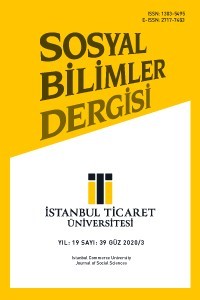MODA GİYİM SEKTÖRÜNDE SÜRDÜRÜLEBİLİRLİK ARAYIŞLARI; YAVAŞ MODA’NIN YÜKSELİŞİ
yavaş moda, hızlı moda, sürdürülebilirlik, algılanan müşteri değeri
Searching for Sustainability in the Fashion Clothing Industry; The Rise of Slow Fashion
slow fashion, fast fashion, sustainability, perceived customer value,
___
- Aaker, D.A.(1996). Measuring brand equity across products and markets. Calif. Manage. Rev. 38, 102–120.
- Bly, S.; Gwozdz, W.; Reisch, L.A. (2015). Exit from the high street: An exploratory study of sustainable fashion consumption pioneers. Int. J. Consum. Stud., 39, 125–135.
- Byun.S.; Sternoquist.B. (2008). The Antecedents of in-store hoaring; measurement and application in the fast fashion retail environment, Int. Rev. Retail Distrib. Consum. Res, 18, 188-147
- Carrigan, M.; Attalla, A. (2001). The myth of the ethical consumer—Do ethics matter in purchase behaviour? J. Consum. Mark. 18, 560–578.
- Castaldo, S.; Perrini, F.; Misani, N.; Tencati, A. (2009). The missing link between corporate social responsibility and consumer trust: The case of fair-trade products. J. Bus. Ethics, 84, 1–15.
- Clark, H. (2008). Slow + fashion: An oxymoron or a promise for the future? Fashion Theory, 12, 427–446.
- Cline, E.L. (2012). Overdressed the shockingly cost of cheap fashion, The Penguin group New York NY USA
- Ertekin, Z.O.; Atik, D. (2015). Sustainable markets: Motivating factors, barriers, and remedies for mobilization of slow fashion. J. Macromarketing, 35, 53–69.
- Day, G.S (1990) Market Driven Strategy; Free Press, New York, NY, USA
- Diddi,S. ; vd. (2019). Exploring young adult consumers’ sustainable clothing consumption intention-behavior gap: A Behavioral Reasoning Theory perspective, Sustainable Production and Consumption, 18, Pages 200-209,
- Fletcher, K (2007). Slow fashion, Ecologist 37, 61
- Fletcher, K (2008). Sustainable fashion and textiles, Design journeys; Routledge; London UK
- Fletcher, K (2010). Slow fashion an invitation for systems change, Fashion Pract. 2, 259-266
- Ghwemwat. P.; Nueon. J.L. (2003). Zara: Fast Fashion Harv. Bus. Sch. Case (9-703-497), 1-35
- Johansson, E. (2010). Slow Fashion: The Answer for a Sustainable Fashion Industry? Master’s Thesis, University of Boras, Boras, Sweden.
- Joy, A.; Sherry, J.F., Jr.; Venkatesh, A.; Wang, J.; Chan, R. (2012). Fast fashion, sustainability, and the ethical appeal of luxury brands. Fashion Theory, 16, 273–296.
- Jung, S.; Jin, B. (2014). Theoretical investigation of slow fashion: Sustainable Future Of The Apparel Industry, Int. J. Consum., 28, 510-519
- Jung, S.; Jin, B. (2019). Creating customer values for the economic sustainability of slow fashion brands. In Proceedings of the International Textile and Apparel Association, Santa Fe, NM, USA, 10–12 November 2015.
- Jung, S.; Jin, B. (2016). From quantity to quality: Understanding slow fashion consumers for sustainability and consumer education. Int. J. Consum. Stud.
- Kane, C. Who made your clothes a slow fashion revolution rises https://fortune.com/2015/04/24/clothes-slow-fashion-zady/ (erişim 19 eylul 2022)
- Khalifa, A.S. (2004)Customer value : A review of recent literature and an integrative Configuration. Manage. Decis., 42, 645–666.
- Mayer, H.; Knox, P.L. (2006). Slow cities; Sustainable places in a fast world. J. Urban Aff. 28, 321-334
- McDougall, G.H.G.; Levesque, T. (2000). Customer satisfaction with services: Putting perceived value into the equation. J. Serv. Mark., 14, 392–410.
- Mercer, A. How NYC’s “Slow Fashion” movement is revolutionising the industry https://www.mic.com/articles/81065/how-nyc-s-slow-fashion-movement-is-revolutionizing-the-industry ( erişim 16 eylül 2022)
- Nilsson, J.H.; Svard, A.; Widarsson, A.; Wirell, T. (2001). Cittaslow eco-gastronomic heritage as a tool for destination development current issues tourism. 14, 373-386
- Sull, D.; Turconi, S. (2011). Fast Fashion Lessons. Bus. Strategy Rev. 19, 4-11
- Pookulangara, S.; Shephard, A. (2013). Slow fashion movement: Understanding consumer perceptions—An exploratory study. J. Retailing Consum. Serv. 20, 200–206.
- Rahman, O.; Gong, M. (2016). Sustainable practices and transformable fashion design – Chinese Professional and consumer perspectives International Journal of Fashion Design Technology and Education 9(3):233-247
- Sheth, J.N.; Newman, B.I.; Gross, B.L. (1991). Why we buy what we buy: A theory of consumption values. J. Bus. Res., 22, 159–170.
- Slow Food USA.: https://slowfoodusa.org/ (erişim 19 eylül 2022)
- Sürücü, L., Şeşen, H., & Maslakçı, A. (2021). SPSS, AMOS ve PROCESS Macro ile İlişkisel, Aracı/Düzenleyici ve Yapısal Eşitlik Modellemesi Uygulamalı Analizler.
- Sürücü, L., & Maslakçı, A. (2020). Validity and reliability in quantitative research. Business & Management Studies: An International Journal, 8(3), 2694-2726.
- Sweeney, J.C.; Soutar, G.N.; Johnson, L.W. (1999). The role of perceived risk in the quality-value relationship: A study in a retail environment. J. Retailing, 75, 77–105.
- Sweeney, J.C.; Soutar, G.N. (2001). Consumer perceived value: The development of a multiple item scale. J. Retailing, 77, 203–220.
- Tabachnick, B. G., & Fidell, L. S. (2013). Using multivariate statistics (6th ed). Pearson Education.
- Tencati, A.; Zsolnai, L. ( 2012). Collaborative enterprise and sustainability: The case of slow fashion food. J.Bus. Ethics, 110, 345-354
- Yang, Z.; Peterson, R.T. (2004). Customer perceived value, satisfaction, and loyalty: The role of switching costs. Psychol. Mark., 21, 799–822.
- Watson, M.Z.; Yan, R.N. (2013). An exploratory study of the decision processes of fast versus slow fashion consumers. J. Fashion Mark. Manage., 17, 141–159.
- Why brands and retailers are running with the slow fashion movement https://www.forbes.com/sites/aliciaadamczyk/2014/11/20/why-brands-and-retailers-are-running-with-the-slow-fashion-movement/?sh=74af7a72c642 ( erişim 16 Eylül 2022)
- Woodruff, R.B.(1997). Customer value: The next source for competitive advantage. J. Acad. Mark. Sci., 25, 139–153.
- Zeithaml, V.A. (1988). Consumer perceptions of price, quality, and value: A means-end model and synthesis of evidence. J. Mark., 52, 2–22.
- ISSN: 1303-5495
- Yayın Aralığı: Yılda 3 Sayı
- Başlangıç: 2002
- Yayıncı: İstanbul Ticaret Üniversitesi
Kadir GÖKOĞLAN, Nazan GÜNGÖR KARYAĞDI
CHRISTOPHER NOLAN SİNEMASININ ARKETİPSEL ANALİZİ
ENTEGRE ENTROPİ-EDAS YAKLAŞIMIYLA LİDER TÜRK İHRACATÇILARININ PERFORMANS ANALİZİ
Ahmed Yusuf SARIHAN, Umut AYDIN
MODA GİYİM SEKTÖRÜNDE SÜRDÜRÜLEBİLİRLİK ARAYIŞLARI; YAVAŞ MODA’NIN YÜKSELİŞİ
İdris ONAY, İsmet Kahraman ARSLAN
OECD ÜLKELERİ SAĞLIK HİZMETLERİ ARZI VE TALEBİ: ÖRNEK UYGULAMA
TÜRKİYE SAĞLIK SİSTEMİNİN DÖNÜŞÜMÜ (2003-13): TIBBİ TEKNOLOJİNİN YAYILIMI
Özel Öğretim Kurumlarında Kurumsallaşmaya İlişkin Okul Müdürlerinin Görüşleri
Seda YÜKSEL NALBANTOGLU, Osman BAYRAKTAR
DÖVİZ PİYASASINA MÜDAHALELERİ ETKİNLİĞİ: T.C. MERKEZ BANKASI
